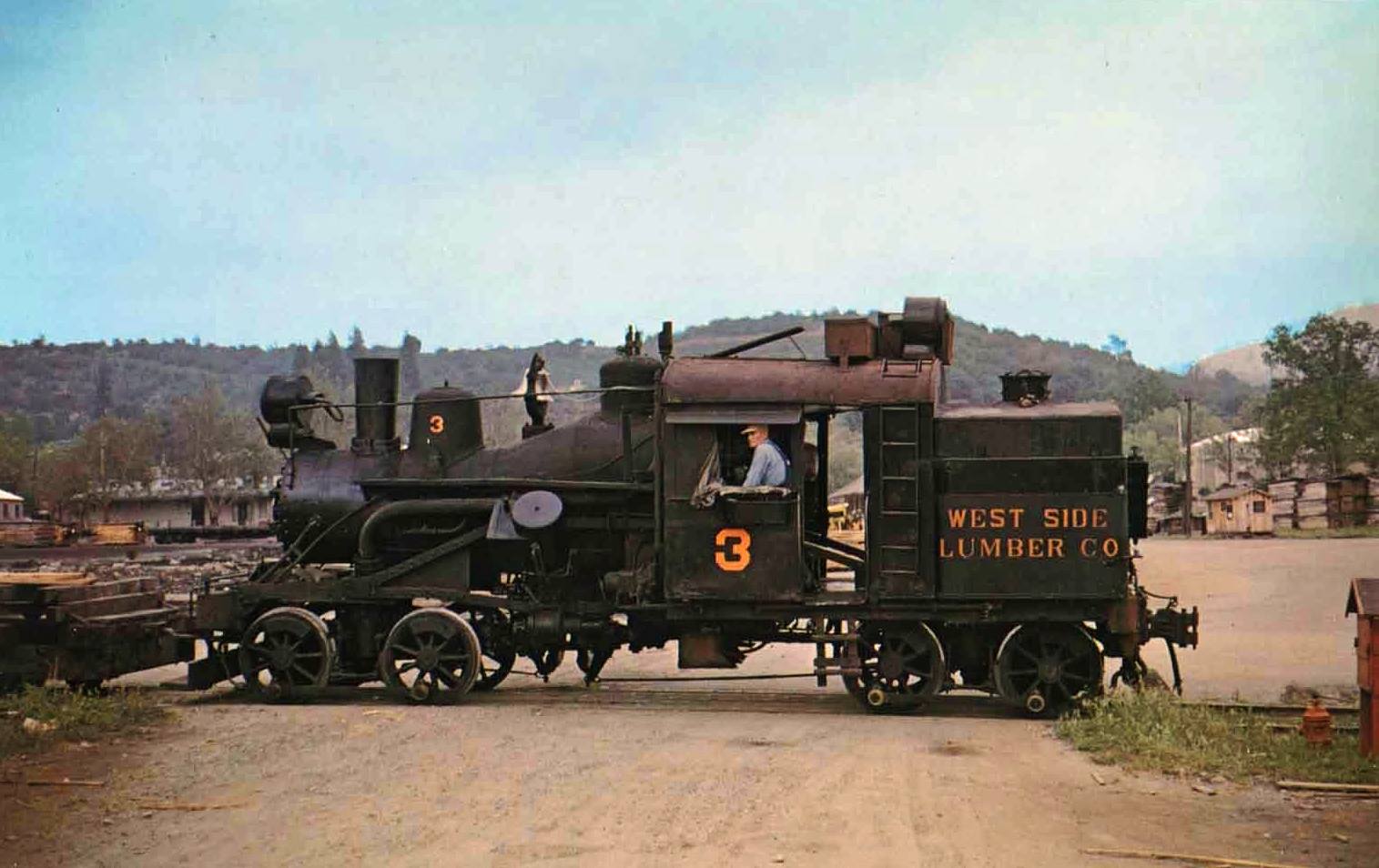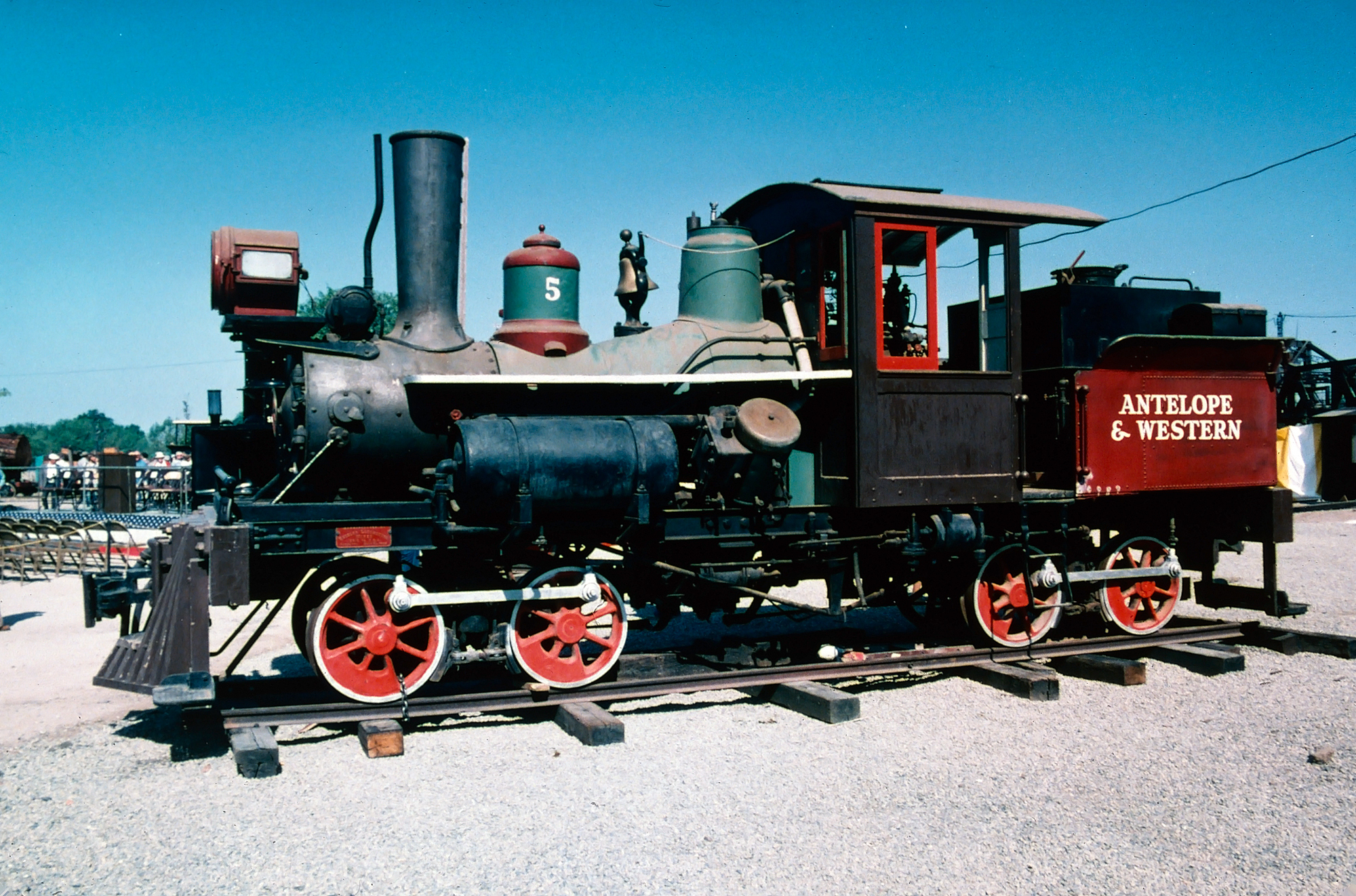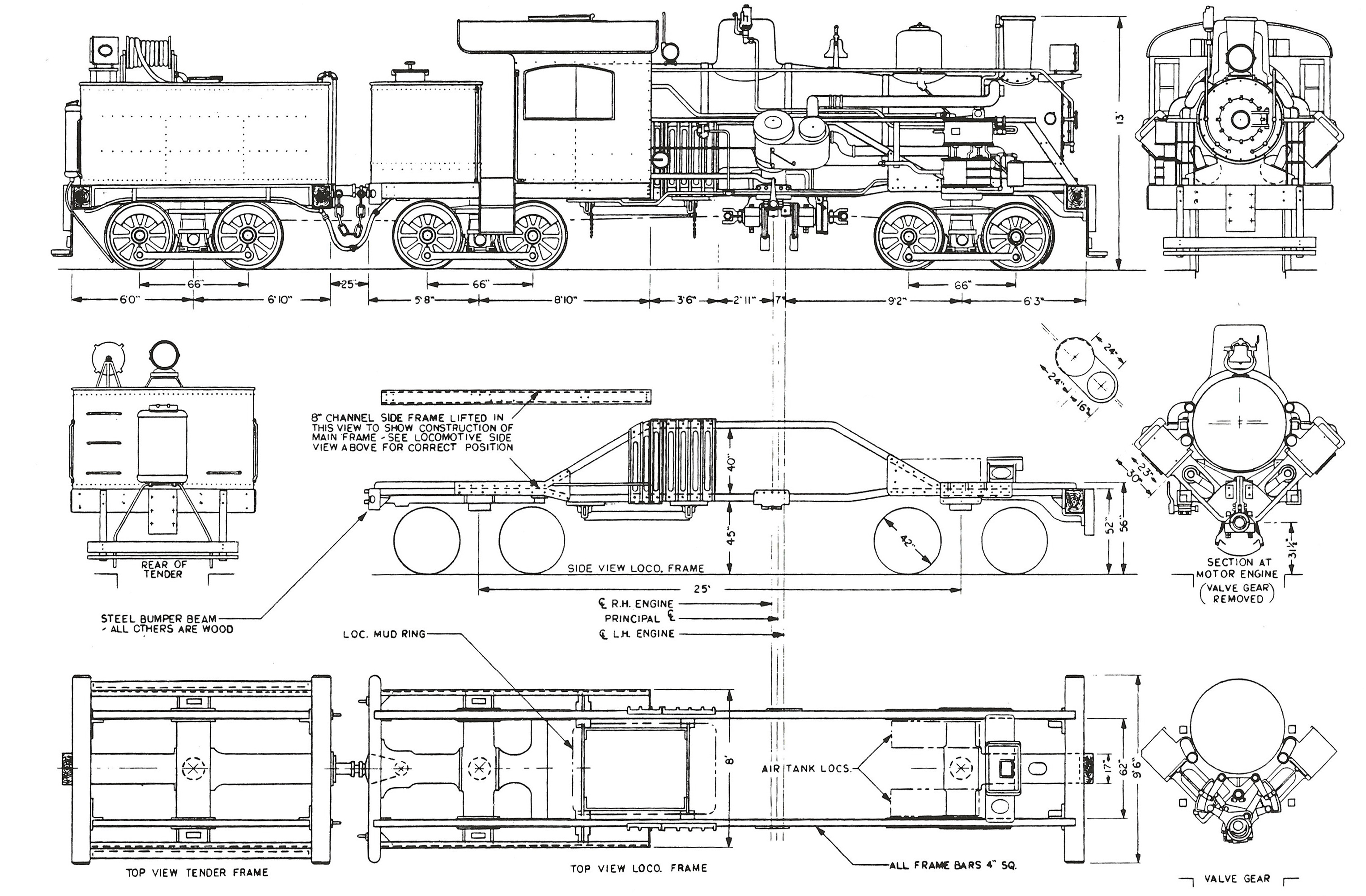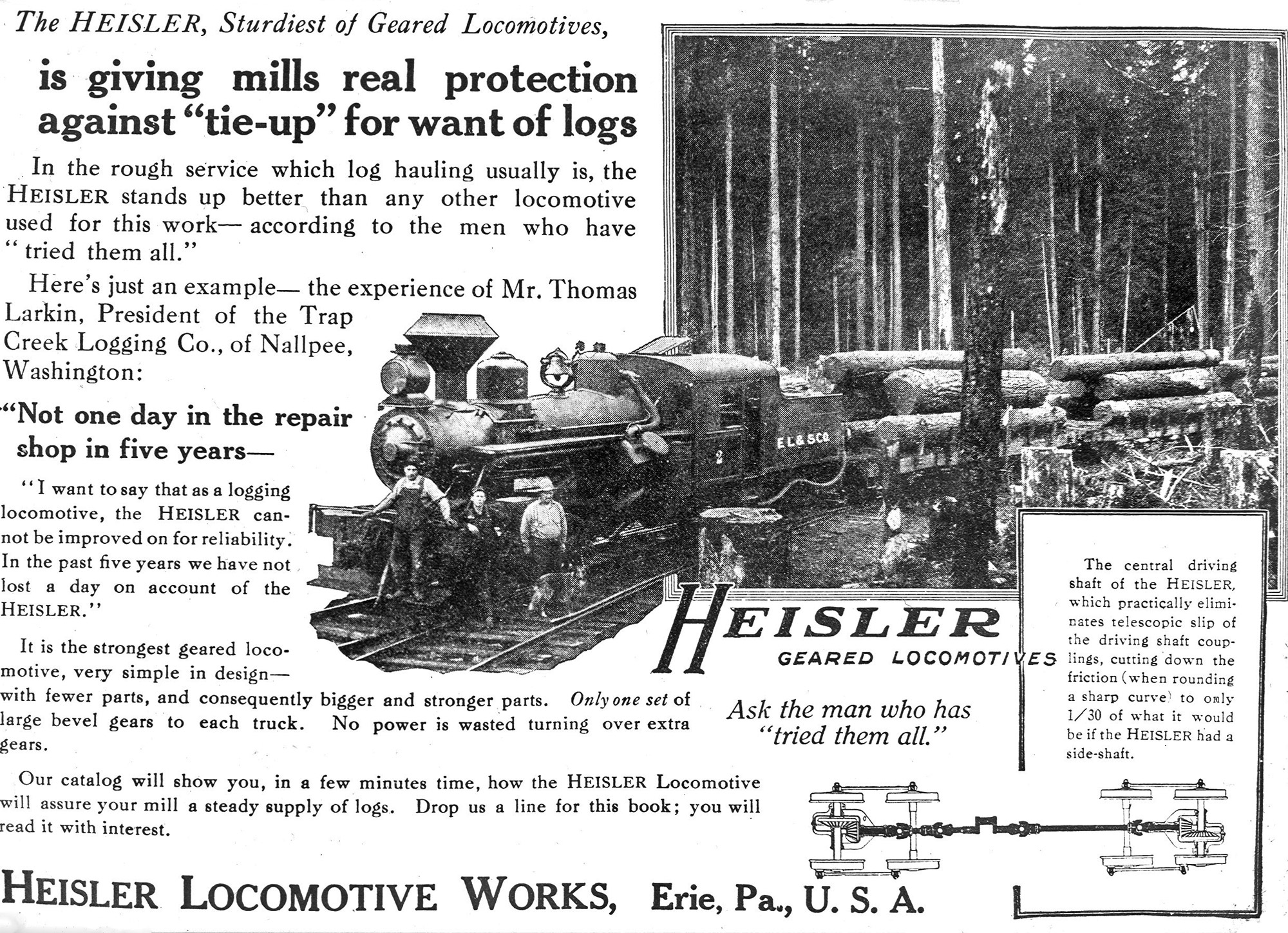"Heisler" Steam Locomotives: Drawing, History, Survivors
Last revised: November 5, 2024
By: Adam Burns
A late entrant in the field of geared steam locomotives, the Heisler faced stiff competition from the already established Shay and Climax designs.
Though it didn’t initially capture a sizable market share, the Heisler eventually made a significant impact, selling several hundred examples and continued production until approximately World War II—notably longer than its Climax rival.
The Heisler boasted a variety of configurations that catered to specific industrial needs, available in both two and three-truck designs. It was also built in nearly a dozen variations, showcasing a versatility that allowed it to adapt to the many demands of its industrial clientele. Today, five Heislers are still in operation with twenty-one others preserved around the U.S. There are 35 Heislers in all preserved worldwide.
Photos
 West Side Lumber Company's little two-truck, narrow-gauge Heisler, #3 (a 1900 product of the Stearns Manufacturing Company of Erie, Pennsylvania), weighing just 37 tons is seen here cleaning out the yard in Tuolumne, California on May 25, 1963 after operations had ceased. Today, the geared steamer is operational on the Roaring Camp Railroads. Glen Beier photo.
West Side Lumber Company's little two-truck, narrow-gauge Heisler, #3 (a 1900 product of the Stearns Manufacturing Company of Erie, Pennsylvania), weighing just 37 tons is seen here cleaning out the yard in Tuolumne, California on May 25, 1963 after operations had ceased. Today, the geared steamer is operational on the Roaring Camp Railroads. Glen Beier photo.Background
The concept of the Heisler arose from the need for powerful, yet versatile locomotives that could handle both the demanding terrain of mountain logging operations and the heavy loads associated with these ventures.
Charles Heisler, an engineer, developed a locomotive that featured a V-twin steam engine—the cylinders arranged at a V-angle—mounted in the center of the boiler.
This design drove a longitudinal drive shaft, which in turn powered the wheels through beveled gears. This arrangement distributed power more evenly and allowed for smoother operation over rough tracks.
Unlike its contemporaries, the Shay and Climax, the Heisler's design offered a more balanced distribution of weight and simpler maintenance due to fewer moving parts exposed to the elements.
The central position of the engine also contributed to better stability and tractive effort, making the Heisler particularly effective on steep grades.
Development
Charles L. Heisler patented his locomotive design in 1892, later refined in subsequent patents. At the time Heisler worked as an engineer at the Dunkirk Engineering Company, a small firm located in Dunkirk, New York.
The company was founded in 1865 as the Dunkirk Iron Works to manufacture small geared steam locomotives for industrial applications.
Heisler's idea was to place the locomotive's two cylinders at a downward, 45-degree angle on each side of the boiler where they met underneath. The cylinders then connected to - and powered - a center drive-shaft that drove each axle via gear casings located between each truck.
The Heisler , while somewhat resembling the Shay, operated in a fashion nearly identical to the Climax, with a notable distinction in the orientation of its cylinders at forty-five degrees—compared to the twenty-five degrees typical of the Climax.
The journey of this locomotive began in 1891 when the first prototype was constructed at Dunkirk. Heisler had initially planned to sell his patent to the company for which he worked.
Diagram
However, facing unforeseen disinterest from Dunkirk, Heisler was compelled to leave and seek other opportunities to market his revolutionary locomotive.
In August of 1894, the Stearns Manufacturing Company of Erie, Pennsylvania, recognized the potential of Heisler's concept and decided to begin production. However, the journey was not without its challenges. By 1904, facing sluggish sales, Stearns ceased production.
The economic downturn caused by the panic of 1907 further complicated matters, plunging the company into a necessary reorganization. Remarkably, it resurfaced within the same year as the Heisler Locomotive Works.
This reinvigorated entity, with a renewed focus and identity, subsequently resumed production of Heisler's design, demonstrating resilience and a steadfast commitment to the locomotive that had initially carried so much promise.
Through 1897 Heisler built his locomotives with only two-trucks. However, during that year he received a patent for a three-truck variant allowing for a heavier locomotive with better adhesion and tractive effort.
While many logging companies and railroads began ordering the three-truck design after this date the company continued to offer it as a two-truck design as well.
Interestingly, unlike the Shay and Climax, Heislers were never given specific classes although they were listed by codes and names in the Heisler catalog.
The locomotive was offered in 11 different versions (ranging in size from 14 to 95 tons) and by the time production had ended roughly 625 had been manufactured.
The earliest utilized coal or wood for fuel although later variants could be ordered as oil burners. The vast majority of Heislers were built for domestic companies while a few were sent to other countries such as New Zealand.
The Heisler held notable advantages over the Shay albeit these did not translate into higher sales.
These included:
- The ability to operate at higher speeds .
- A cheaper price tag.
- Lower maintenance costs thanks to a simplified transmission system.
 Antelope & Western 2-truck Heisler #5 is seen here on display in Sacramento, California, circa 1981. The locomotive was built for the Lake County Box & Lumber Company in 1911 and later worked for Richardson Lumber and the Holmes Brothers. It then spent time in excursion service operating on the "Antelope & Western" in Roseville, California. It is currently privately owned by Leslie Wilmunder of Palermo, California. William Myers photo. American-Rails.com collection.
Antelope & Western 2-truck Heisler #5 is seen here on display in Sacramento, California, circa 1981. The locomotive was built for the Lake County Box & Lumber Company in 1911 and later worked for Richardson Lumber and the Holmes Brothers. It then spent time in excursion service operating on the "Antelope & Western" in Roseville, California. It is currently privately owned by Leslie Wilmunder of Palermo, California. William Myers photo. American-Rails.com collection.Legacy
As the 20th century progressed, the advent of diesel-electric technology led to the gradual phase-out of steam locomotives, including Heislers. Many logging companies by the 1950s had either switched to small diesel switchers or simply abandoned rail oeprations altogether in favor of trucks.
By the 1940s, production had dwindled, and the last Heisler locomotive was built in 1941. Despite the end of their production, many Heisler locomotives continue to be cherished by railroad historians and preservationists.
More than two dozen Heislers have been preserved across the United States, with five currently operational at tourist and heritage railroads.
These locomotives not only serve as a functional reminder of a bygone era but also offer invaluable insights into the technological advancements and challenges of historical rail transportation.
The Heisler represents a remarkable combination of innovation, durability, and adaptability, reflecting the unique demands and ingenuity of early 20th-century railroading.
Through ongoing preservation efforts, the legacy of the Heisler locomotives continues to enchant and educate future generations on the rich history of rail transportation.
Preservation
While the Heisler saw fewer sales than either the Shay or Climax it did have a few advantages against its more successful competition.
One of these is at the famous Cass Scenic Railroad in Cass, West Virginia. Cass Scenic is home to the largest collection of operating Shays in the country and is well worth the trip to ride this historic operation if you have the chance.
Other places to catch Heislers in action include the Sumpter Valley Railway, Silver Creek & Stephenson Railroad, Oregon Coast Scenic Railroad, and the Roots of Motive Power (in Willits, California).
Extant Examples
Included within the below list are also surviving fireless 0-4-0Fs which were constructed by Heisler.
| Engine Number | Class | Wheel Arrangement | Track Gauge | Original Owner/Preserved As | Current Location | Current Status | Builder Information | Notes |
|---|---|---|---|---|---|---|---|---|
| 1 | 35 Ton | 0-4-0F | 4' 8 ½" | Potomac Electric Power Company | B&O Railroad Museum (Baltimore) | Display | Heisler #43 (1938) | - |
| 3 | 22 Ton | Heisler 2-Truck | 4' 8 ½" | Holly Ridge Lumber Company | Dr. Marvin Kendell Estate (Barnet, Vermont) | Display | Heisler #1415, 1920 | - |
| 1 | 42 Ton | 0-4-0F | 4' 8 ½" | Sweetline Railroad | Depot Restaurant (Caro, Michigan) | Display | Heisler #38 (1936) | Built as Continental Can #1. |
| 2 | 42 Ton | Heisler 2-Truck | 4' 8 ½" | Forest Products Chemical Company | Cass Scenic Railroad State Park (Cass, West Virginia) | Stored | Heisler #1589 (1929) | - |
| 6 | 90 Ton | Heisler 3-Truck | 4' 8 ½" | Cass Scenic Railroad (Meadow River Lumber Company) | Cass Scenic Railroad State Park (Cass, West Virginia) | Overhaul | Heisler #1591 (1929) | - |
| 5 | 62 Ton | Heisler 2-Truck | 4' 8 ½" | Buffelen Lumber & Manufacturing Company | Oregon Coast Scenic Railroad (Centralia, Washington) | Stored | Heisler #1462 (1922) | - |
| 9 | 55 Ton | Heisler 2-Truck | 4' 8 ½" | Campbell Limestone | Southeastern Railway Museum (Duluth, Georgia) | Cosmetically Restored (Display) | Heisler #1479 (1923) | Donated by Cambell Limestone successor Vulcan Materials in 1979. |
| 7 | 80-ton | Heisler 3-Truck | 4' 8 ½" | Moore-Keppel & Company/Middle Fork Railroad | Durbin & Greenbrier Valley Railroad (Durbin, West Virginia) | Stored | Heisler #1607 (1939) | - |
| 10 | 78-Ton | Heisler 3-Truck | 4' 8 ½" | Pickering Lumber Company | Mt. Rainier Scenic Railroad (Elbe, Washington) | Display | Heisler #1252 (1912) | - |
| 3 | 42 Ton | Heisler 2-Truck | 4' 8 ½" | Fisher Lumber Company | JM Jones Lumber (Ferriday, Louisiana) | Stored | Heisler #1513 (1925) | - |
| 2 | 36 Ton | Heisler 2-Truck | 4' 8 ½" | Silver Creek & Stephenson | Silver Creek & Stephenson Railroad (Freeport, Illinois) | Operational | Heisler #1260 (1912) | Built as Louise Lumber Company (#2) of Hawkes, Mississippi. Renamed the Poplarville Saw Mill Company (Poplarville, Mississippi) in 1916. Later sold to the Lamb-Fish Lumber Company (Charleston, Mississippi), then to the Turner-Farber-Love Company (1923), and was finally acquired by the Santee River Hardwood Company (#7) of St. Stephen, South Carolina in 1928. Between 1962-1974 it hoste excursions on the Maggie Valley Railroad (Maggie Valley, South Carolina) before it was sold to the Whitewater Valley Railroad. It was purchased by the Stephenson County Antique Engine Club in 1982. |
| 2 | 60 ton | Heisler 2-Truck | 4' 8 ½" | Curtiss Lumber Company (Vancouver Plywood) | Oregon Coast Scenic Railroad (Garibaldi, Oregon) | Overhaul | Heisler #1198 (3/1910) | - |
| 3 | 63 ton | Heisler 2-Truck | 4' 8 ½" | Craig Mountain Lumber Company | Oregon Coast Scenic Railroad (Garibaldi, Oregon) | Operational | Heisler #1364 (1917) | - |
| 1 | 86 Ton | Heisler 3-Truck | 4' 8 ½" | Pickering Lumber Company | Oregon Coast Scenic Railroad (Garibaldi, Oregon) | Display | Heisler #1272 (1913) | - |
| 21 | - | 0-4-0F | 4' 8 ½" | Hercules Powder Company | Southern Railway Depot (Hattiesburg, Mississippi) | Display | Heisler #34 (1935) | - |
| 92 | 90 Ton | Heisler 3-Truck | 4' 8 ½" | Potlatch Forests, Inc. | Lewiston, Idaho | Display | Heisler #1502, 1924 | - |
| 4 | 32 Ton | Heisler 2-Truck | 4' 8 ½" | International Shoe Company | White Mountain Central Railroad/Clark's Trading Post (Lincoln, New Hampshire) | Display | Heisler #1594 (1929) | - |
| 3 | 22 Ton | Heisler 2-Truck | 4' 8 ½" | Santee River Hardwood Company | Southern Forest Heritage Museum (Long Leaf, Louisiana) | Restoration | Heisler #1081 (1906) | - |
| 2 | 75 Ton | Heisler 3-Truck | 4' 8 ½" | Pickering Lumber Company | Travel Town Museum (Los Angeles) | Display | Heisler #1369 (1918) | Built as Hetch Hetchy Railroad #6. |
| 3 | 40 Ton | Heisler 2-Truck | 36" | Sumpter Valley Railway | Sumpter Valley Railway (McEwen, Oregon) | Operational | Heisler #1306 (1915) | Built as W.H. Eccles Lumber Company #3. Only surviving wood-burning Heisler. |
| 91 | 90 Ton | Heisler 3-Truck | 4' 8 ½" | Condon, Kinzua & Southern Railroad (Kinzua Pine Mills) | Mineral Shops/Mt. Rainier Scenic Railroad (Mineral, Washington) | Stored | Heisler #1595 (12/1929) | Built as Condon, Kinzua & Southern #102. |
| 6 | 65 Ton | 0-6-0F | 4' 8 ½" | Cleveland Electric Illuminating Company | Lake Shore Railway Museum (North East, Pennsylvania) | Display | Heisler #39 (1937) | - |
| 1 | 18 Ton | Heisler 2-Truck | 36" | Richardson Lumber Company | Palermo, California | Privately Owned | Heisler #1225 (1911) | - |
| 1 | 22 Ton | Heisler 2-Truck | 4' 8 ½" | Phenix Marble Company | Passumpsic Railroad (Passumpsic, Vermont) | Operational | Heisler #1468 (1922) | - |
| 33 | - | 0-4-0F | 4' 8 ½" | T. R. Miller Company | Pensacola, Florida | Display | Heisler #33 (1934) | - |
| 2 | - | 0-4-0F | 4' 8 ½" | Connecticut Power Company | Rochester & Genesee Valley Railroad Museum (Rush, New York) | Display | Heisler #60 (5/1941) | - |
| 9 | 36 Ton | Heisler 2-Truck | 4' 8 ½" | Mt. Tamalpais & Muir Woods Railway | Pacific Lumber Company (Scotia, California) | Restoration | Heisler #1446 (1920) | Operated on the MT&MW from 1921 to 1924. |
| 4 | 50 Ton | Heisler 2-Truck | 4' 8 ½" | Ohio Match Company | Northwest Railway Museum (Snoqualmie, Washington) | Display | Heisler #1488 (1923) | Built as Ohio Match Company #4. Later sold to National Pole & Treating Company, later renamed Minnesota & Ontario Paper Company. Acquired by Charles Morrow of Snoqualmie, WA in 1958, and then sold to the Northwest Railway Museum in 1967. |
| 2 | 70 Ton | 0-6-0F | 4' 8 ½" | Union Electric Company | Museum of Transportation (St. Louis) | Stored | Heisler #56 (1940) | |
| 111 | - | 0-4-0F | 4' 8 ½" | Bethlehem Steel | Railroad Museum of Pennsylvania (Strasburg) | Display | Heisler #58 (1941) | Named 'III Aces'. |
| 4094 | - | 0-8-0F | 4' 8 ½" | Pennsylvania Power & Light Company (Hammermill Paper) | Railroad Museum of Pennsylvania (Strasburg) | Display | Heisler #47 (1940) | Built for display at the 1940 New York World's Fair. Largest fireless design ever built. |
| 4 | 53 Ton | Heisler 2-Truck | 4' 8 ½" | Chicago Mill & Lumber Company | Railroad Museum of Pennsylvania, Strasburg, PA | Display | Heisler #1375 (1918) | Built as W.T. Smith Lumber Company #10. It was later sold to Angelina Hardwood Lumber Company (#6) of Ferriday, Louisiana, then the Chicago Mill & Lumber Company of Tallulah, Louisiana. Acquired by the museum in 1966. |
| 2 | - | 0-4-0F | 4' 8 ½" | Columbus & Southern Ohio Electric Company (Groveport, Ohio plant) | Age of Steam Roundhouse (Sugarcreek, Ohio) | Display | Heisler #54 (3/1940) | Acquired by Age of Steam in 2018. |
| 5 | 86 Ton | Heisler 3-Truck | 4' 8 ½" | Pickering Lumber Company | Niles Canyon Railway (Sunol, California) | Stored | Heisler #1268 (1913) | - |
| 2 | 42 Ton | Heisler 2-Truck | 4' 8 ½" | Broughton Lumber Company | Tillamook Air Museum (Tillamook, Oregon) | Display | Heisler #1155 (1909) | - |
| 1 | 47 Ton | Heisler 2-Truck | 4' 8 ½" | Bluestone Mining & Smelting Company | Roots of Motive Power (Willits, California) | Operational | Heisler #1351 (1916) | - |
Sources
- Adams, Kramer A. Logging Railroads Of The West. New York: Bonanza Books, 1961.
- Fetters, Thomas. Logging Railroads Of South Carolina. Forest Park: Heimburger House Publishing Company, 1990.
- Fetters, Thomas. Logging Railroads Of The Blue Ridge And Smoky Mountains, Volume I (Gold Mountain, Black Mountain And White Top). Hillsboro: TimberTimes, 2007.
- Fetters, Thomas. Logging Railroads Of The Blue Ridge And Smoky Mountains, Volume 2 (Tallulah Falls, Anna Ruby Falls, And Jeffrey's Hell). Hillsboro: TimberTimes, 2010.
- Gove, Bill. Logging Railroads Of The Adirondacks. Syracuse: Syracuse University Press, 2006.
- Gove, Bill. Logging Railroads Of New Hampshire's North Country. Littleton: Bondcliffs Books, 2010.
- Kline Jr. Benjamin F.G. Tall Pines And Winding Rivers: The Logging Railroads Of Maryland. Strasburg: The Friends Of The Railroad Museum Of PA, 2007 (Second Edition).
- King, Frank A. Minnesota Logging Railroads. Minneapolis: University Of Minnesota Press, 2003 (First University Of Minnesota Press Edition).
- Labbe, John T. and Replinger, Peter J. Logging To The Salt Chuck. Seattle: North West Shore Line, 1990.
- Lawson Jr., Thomas. Logging Railroads Of Alabama. Birmingham: Cabbage Stack Publishing, 1996.
- Warden, William E. West Virginia Logging Railroads. Lynchburg: TLC Publishing, 1993.
Recent Articles
-
Ohio - Whiskey - Train Rides
Dec 24, 25 05:47 PM
Ohio, with its rich history and scenic landscapes, offers an unusual yet delightful experience for spirit enthusiasts and travel aficionados alike: whiskey train rides. -
California Thomas The Train Rides
Dec 24, 25 05:44 PM
Held at various railroad museums and heritage railways across California, these events provide a unique opportunity for children and their families to engage with their favorite blue engine in real-li… -
Texas Thomas The Train Rides
Dec 24, 25 05:42 PM
In the heart of Texas, where everything is said to be bigger and bolder, lies an event that captures the imagination of children and families alike - A Day Out With Thomas.





